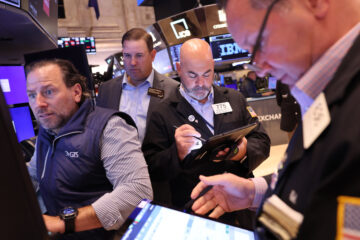The Fed has lifted interest rates 3.75% since it started its tightening campaign in March.
Many economists and investors believe that the Federal Reserve’s interest-rate hikes will push the economy down sharply next year, perhaps even triggering a recession.
The Fed has lifted rates 3.75 percentage points since it started its campaign in March. And most experts anticipate the Fed will increase rates another 0.5% on Dec. 14, slowing from the last four rate increases of 0.75%..
A lot of these experts maintain that the economic slowdown triggered by Fed rate hikes will force it to pivot to rate cuts next year to revive the economy. But Goldman Sachs chef economist Jan Hatzius doesn’t see it that way.
“We expect a further slowdown in the [interest-rate] hiking pace to 25 basis points [0.25 percentage point]at the February meeting,” he said in a question-and-answer session with Goldman Sachs clients.
“Beyond February, we see two more 25 basis point hikes in March and May.” That’s close to experts’ consensus, though maybe a little higher.
Shutterstock
No Rate Cuts Until 2024
But after that, Hatzius does get contrarian. He sees no Fed rate cuts until 2024. “as the economy remains more resilient than projected by most forecasters and market participants.”
As for next year, Hatzius’ forecast puts the federal funds rate at 5% to 5.25% at the end of May.
But Lindsey Piegza, chief economist at securities firm Stifel, says the Fed may have to go as high as 9%.
“The recent improvement in inflation pressures turning over from peak levels has seemingly … blinded many investors to the need for the Fed to aggressively continue along a pathway to higher rates,” she said.
The 7.7% year-on-year October increase in consumer prices represents improvement from September’s 8.2% surge, Piegza acknowledges.
But, “it is hardly anything to celebrate or a clear signal for the Fed to move to easier policy, with [the Fed’s 2% inflation target] still a distant accomplishment,” she said.
Economic Weakness Until 2075
Meanwhile, Goldman Sachs economists have published a commentary with projections for the global economy through 2075. If they’re right, don’t expect boom times.
“Slower global potential growth, led by weaker population growth” will prevail, the economists wrote. “Our projections imply that global growth will average a little under 3% per year over the next 10 years and will be on a gradually declining path.”
That’s down from 3.6% in the decade preceding the 2008 financial crisis.
The main reason for the predicted sluggishness is slowing labor-force growth, the economists said. Global population growth has halved over the past 50 years, from 2% per year to less than 1%, and is expected to fall to close to zero by 2075, they said.
The next 10 years may not be so kind to the U.S. economy, the Goldman Sachs experts said. The last decade represents a period of “U.S. exceptionalism that is unlikely to be repeated,” they said.
“The U.S. relative performance has been stronger than expected” during the past 10 years,” they said. “However, history suggests it is unlikely to repeat…. U.S. potential growth remains significantly lower than that of large emerging market economies.”
And the economists expect some of the dollar’s “exceptional strength” of recent years to be unwound over the next 10 years.


